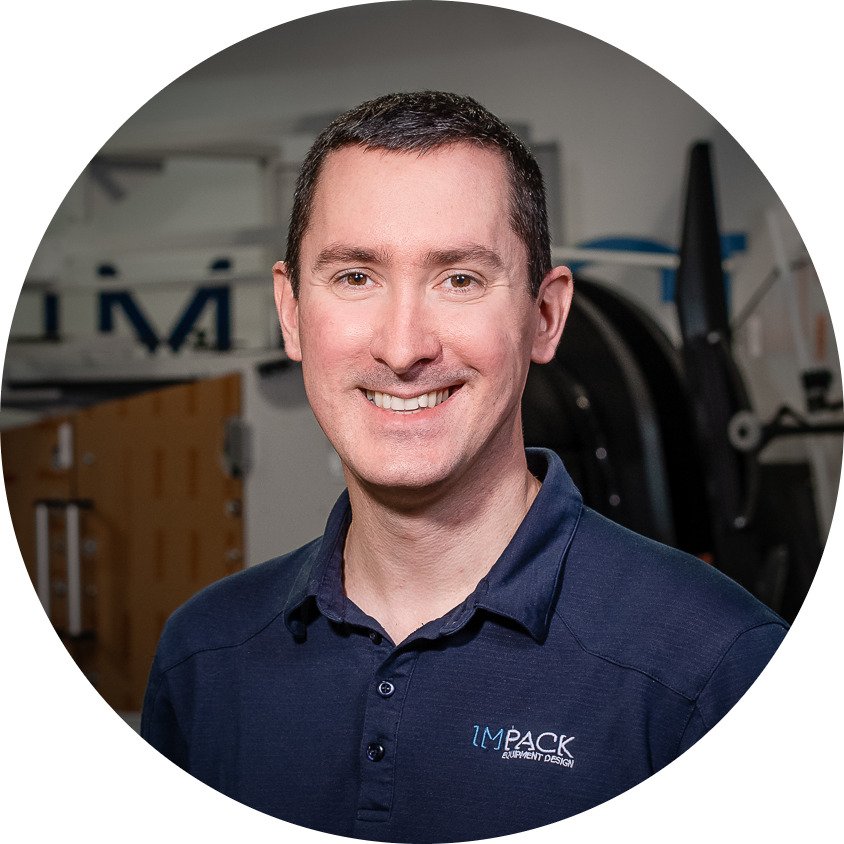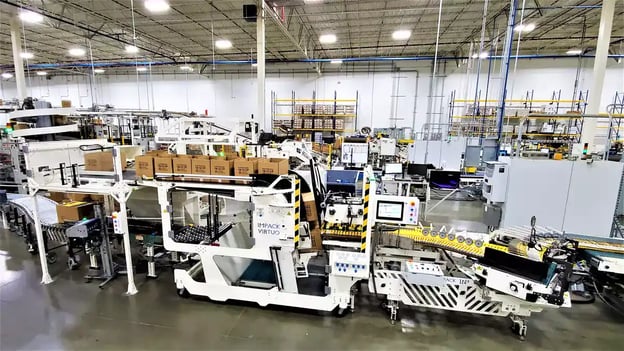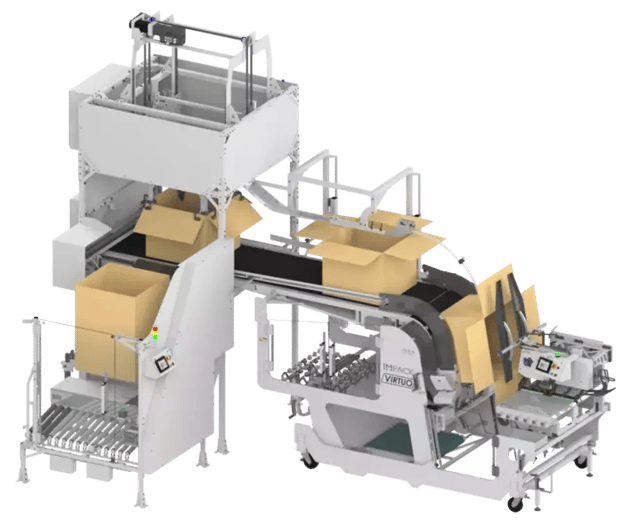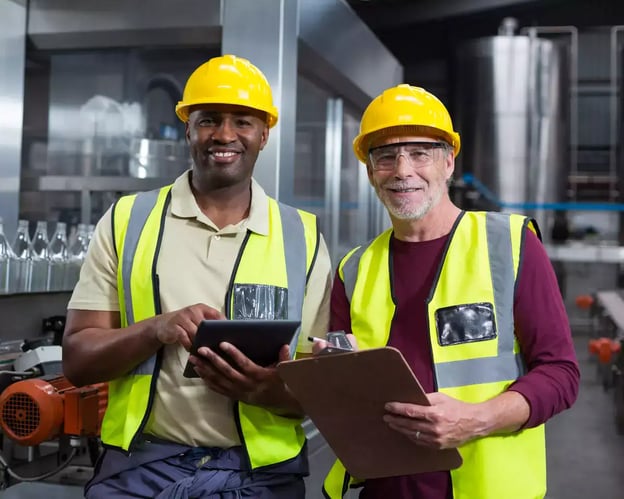What is an Automatic Packer and How Can It Improve My Packing Process?
Are you struggling to improve your folder-gluer's productivity?
8 min read
 Mathieu Tremblay
:
February 1, 2022
Mathieu Tremblay
:
February 1, 2022

You and your competitors have 1 common goal:
To serve more clients.
Because more clients mean more business and more cash.
And the only way you can serve more clients is by reaching higher packing speeds.
If you can somehow pack your boxes faster, you can produce more output, close more contracts, and make more profit.
If you can somehow reduce your packing staff, you can cut down on costs and make more profit.
What if I told you that you can increase your packing speed by 25%, 50%, or even 100%?
What if I told you that you can reduce your operators by 1 or 2 people and dramatically increase your folder-gluer output?
It is possible and easily achievable.

At IMPACK, we work with small companies, medium-sized companies, and some of the biggest names in the packaging industry.
And having worked for over 20 years in the packaging industry, I have seen what the most and least successful packaging producers do.
Here’s a secret that I’ll let you on: The biggest companies in the packaging industry all have Automatic or Fully-Automatic packers.
Yep, that’s it. That’s their secret.
They automate their case packing process so that they depend less on operators, reach top packing speeds, and achieve remarkable levels of productivity.
This VIDEO + ARTICLE will cover everything you need to know about a Fully-Automatic packer: What it is, its pros and cons, and how to decide whether a Fully-Automatic packer is right for you or if there are better options.
Let’s get right into it!

First, you should know that all packing systems fall into one of the following four levels of automation:
Manual packing
Semi-Automated packing
Automated packing
Fully-Automated packing
In other words, there are Manual packing systems, Semi-Automatic packing systems, Automatic packing systems, and Fully-Automatic packing systems.
And by “packing systems” we are referring to folder-gluer packers, folder-gluer stackers, or any packing help/aid that is added to your folding gluing line to help you automate your case packing or bundling/stacking process.
🔍 Recommended: Considering adding a packing system to your folder-gluer but still unsure about what level of automation your company needs? Find out the right level of automation for your company by reading “What’s the Difference between Manual, Semi-Auto, Auto & Fully-Auto Folder-Gluer Packers?”

A folder-gluer packer is a packing system that partially, or fully, automates your case packing process hence allowing you to improve your folder-gluer’s productivity, reduce the number of operators or packing staff required, cut down on costs, and reach top packing speeds.
A folder-gluer packer is installed behind the folder-gluer and after the pre-packer(s).
That is, a packer is installed at the end of the flow of the gluing line.


Fully-Automated packing offers the highest possible level of automation.
A Fully-Automatic packer automates your entire case packing process so that your operator is no longer required to be present.
That is, your case packing process becomes 100% automated with zero human intervention.
Upgrading to a Fully-Automated process would mean automating what the human was previously doing in the Automated process which is to place the empty cases into the machine.
A Fully-Automatic packer feeds itself with empty cases, manages the filled cases, and seals the filled cases fully automatically without requiring the presence of an operator (or any other humans) while running.
The operator is only ever involved during setups and adjustments. But once the machine is set up and running, the operator can move to higher value-added activities.
When it comes to comparing Manual packers, Semi-Automatic packers, Automatic packers, and Fully-Automatic packers, Fully-Automatic packers are easily the most tempting option that clients want.
However, it is also more complex, more expensive, and more technical.
But, for some companies, a Fully-Automatic packer is the most practical option that makes sense for their production.
IMPACK’s Fully-Automatic packer is the “Virtuo + ACF.”
🔍 Recommended: If you’re interested in learning more about IMPACK’s Virtuo + ACF, the article “How to Further Automate Your Virtuo Packer: Virtuo and ACF Combination” covers everything you need to know about the Virtuo + ACF and when you can add the ACF if you already have a Virtuo packer.

Top speed: The biggest selling point of a Fully-Automatic packer is its top production speed. While the Automatic packer offers a high production speed, the speed of the Fully-Automatic packer is unmatched. This is because the Fully-Automatic packer is designed for extreme productivity and top-notch efficiency.
Unmatched constant productivity: Fully-automatic packers take no breaks and no vacations. Operating 24/7, the capabilities of those machines are unmatched.
No humans involved: Going full-auto would mean that the machine can now place the empty cases by itself then take the filled cases and seal them fully automatically. The operator is only ever involved during setups and adjustments. This is ideal for companies positioned in areas with scarce operators or rising labor wages.
Employees are no longer subjected to a high level of manual work and an environment that leads to repetitive strain injuries as with Manual packing. This thereby results in less absence due to health issues.
If you already have a “Virtuo Intermediate” or “Virtuo Advanced” packer, you can easily upgrade to a Fully-Automatic packer at any point in time by adding IMPACK’s Automatic Case Feeder.
Possible to have a box turner that allows you to choose on which side to turn the boxes (left, right, straight through or 180 degrees).
More costly and complex to install: Because Fully-Automatic packers involve a precise and technical installation process, it is no surprise that they are more expensive than Semi-Automatic packers and Automatic packers as a one-time cost. Plus, they are more limited in terms of what they can do.
Requires a third-party case erector and several conveyors which increase the overall cost.
Laser-focused on dedicated tasks: With a Fully-Automatic packer, the scope must be clearly defined, always the same, never changing, and always accurate. Unlike Semi-Automatic packers which are super versatile and flexible, Fully-Automatic packers are dedicated to specific productions and are unforgiving towards errors in surrounding processes (folder-gluer and case erectors for example).
Requires strict safety measures: With a Semi-Automatic packer, you can process whatever box you want through your folder-gluer as you have the power of easy access and the flexibility to take out any box you want with your own hands, at any time, and place it into the case. With an Automatic packer, your versatility is more limited but you still have access to your filled cases. In contrast, when it comes to a Fully-Automatic packer, it has to be 100% safe. If there is ever a problem, you have to shut it down to zero with an emergency stop, otherwise, it is too dangerous for a human.
Requires a larger footprint: A Fully-Automatic packer occupies a larger footprint than a Collecting Table, a Semi-Automatic packer, and an Automatic packer.

A lot of clients get very excited when companies propose and discuss Automatic and Fully-Automatic packers.
And it can be an easy sale for us, packaging equipment suppliers, driven by the client’s pure temptation of having a robot doing the whole job, but that’s the perception in theory.
In practice, things are very different, and we want to make sure that you’re aware of this before you commit to any packaging equipment supplier.
Here’s the truth that most suppliers don’t want you to know: A Fully-Automatic packer is far more expensive than a Semi-Automatic packer or an Automatic packer and it won’t make you go faster than an Automatic packer.
Why?
A Fully-Automated process is one step above an Automated process, And in a Fully-Automated process, you are, in essence, automating the human that simply used to put empty cases into the machine.
This operator was never really a bottleneck so the folder-gluer packer would never be limited by this person who’s simply putting empty cases into the machine.
The folder-gluer packer was already doing everything else automatically in the Automated process and removing that operator who simply fills the cases won’t make you go any faster. You would run at the exact same speed but with better efficiency.
So, here’s an interesting question for you:
If a Fully-Automatic packer runs at the same speed as an Automatic packer and all you’re doing is automating the human that used to fill the packer with empty cases, is automating that human worth the extra cost?
The answer to this question is very different from company to company depending on the labor wages in your region, operator job scarcity, and your production mix.
In some cases, a Fully-Automatic packer is the best option, while in other cases, a Semi-Automatic packer or an Automatic packer could be better options.

Alright. Now that you have a better understanding of what a Fully-Automatic packer is, the benefits it can provide to your packing process, and its advantages and disadvantages, you’re probably wondering whether you should invest in a Fully-Automatic packer or consider other options.
If you have a very tight budget, never had a packer, and you’re not ready to automate your case packing process, then investing in a Collecting Table (a Manual packing aid) could be a great start.
Examples of the most popular Collecting Tables in the Western market include: IMPACK’s Packing Help Stations, Bobst’s Handypack GT, KBA Duran's Omega Pack Station, and Tünkers' FAS 480.
🔍 Recommended:
Get more info here about Collecting Tables, their pros and cons, and how to decide whether a Collecting Table is right for your company or not.
Learn more here about IMPACK’s Collecting Tables: The Packing Help Stations.
Compare Collecting Tables to Semi-Automatic packers to find out what machine is best for your production.
Now, if you are looking to take the first step towards automating your case packing process and you have variable production runs, small to medium-sized boxes, a wide and diverse variety of box formats, and complex boxes that require constant adjustments/quality control checks, then investing in a Semi-Automatic packer would be your best option.
IMPACK’s Ergosa packer is our top sold machine and one of the only Semi-Automatic packers that exists, to date, on the market.
🔍 Recommended:
Get more info here about Semi-Automatic packers, their pros and cons, and how to decide whether a Semi-Automatic packer is right for your company or not.
Learn more here about IMPACK’s Semi-Automatic packer: The Ergosa packer.
Compare Collecting Tables to Semi-Automatic packers to find out what machine is best for your production.
If you have long production runs, medium to very large-sized boxes, a limited variety of similar box formats, and simpler boxes that do not need constant adjustments/quality control checks, then investing in an Automatic packer is the ideal option for your company.
Examples of the most popular Automatic packers in the Western market include: IMPACK’s Virtuo packer, Bobst’s CartonPack 4, Heidelberg’s Diana Packer, WSI Global’s ExpressPack, and Graphic West Packaging’s J-Pack.
🔍 Recommended:
Get more info here about Automatic packers, their pros and cons, and how to decide whether an Automatic packer is right for your company or not.
Learn more here about IMPACK’s Automatic packer: The Virtuo packer.
Compare Semi-Automatic packers to Automatic/Fully-Automatic packers to find out what machine is best for your production.
And finally, if your company’s top priority is productivity with an extreme focus on dedicated production and you want to reach a zero-human operation, then investing in a Fully-Automatic packer is the right option for your company.
Examples of the most popular Fully-Automatic packers in the Western market include: IMPACK’s Virtuo + ACF, Bobst’s Carton Pack 4 + optional case erector, WSI Global's ExpressPack + optional case erector, and CSI Packaging’s I-Pack.
🔍 Recommended:
Learn more here about IMPACK’s Fully-Automatic packer: The Virtuo + ACF combination.
Compare Automatic packers to Fully-Automatic packers to find out what machine is best for your production.
If you’re ready to choose a packing system but you still have questions, 📞 Get in Touch, we’d love to answer all your questions and offer you a FREE productivity analysis that would show you what machine is best for you and when you’ll receive your return from your investment!
Compare Automatic packers to Fully-Automatic packers and evaluate their pros and cons to discover what level of automation is best for your company.
Read “How to Further Automate Your Virtuo Packer: Virtuo and ACF Combination” to learn all about IMPACK’s Virtuo + ACF Fully-Automatic combination and when you can upgrade to a Fully-Automated packer.
Get a detailed breakdown of the costs of IMPACK’s different packers by checking out “How Much Does a Folder-Gluer Packer Cost?”
And finally, find out what folder-gluer packer is right for your company’s production & budget by reading "How to Choose the Right Folder-Gluer Packer."

Are you struggling to improve your folder-gluer's productivity?
![What is a Semi-Automatic Packer and How Can It Improve My Packing Process? [+ VIDEO]](https://impack.ca/hubfs/X21-057.png)
If you’re looking for ways to improve your folder-gluer’s productivity, increase your folder-gluer’s output, and reach higher speeds, you’re probably...
![Automatic Vs. Fully-Automatic Packers: Which Should You Choose? [+ VIDEO]](https://impack.ca/hubfs/X21-054-1.jpg)
If you’re searching for ways to improve your folder-gluer productivity, you’ve probably noticed that some of your competitors have Semi-Automatic...